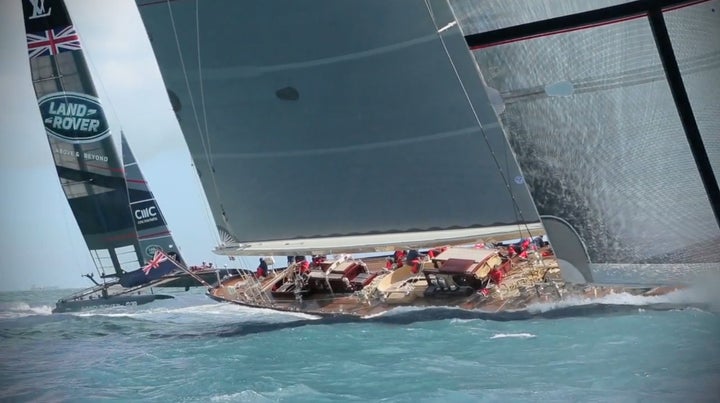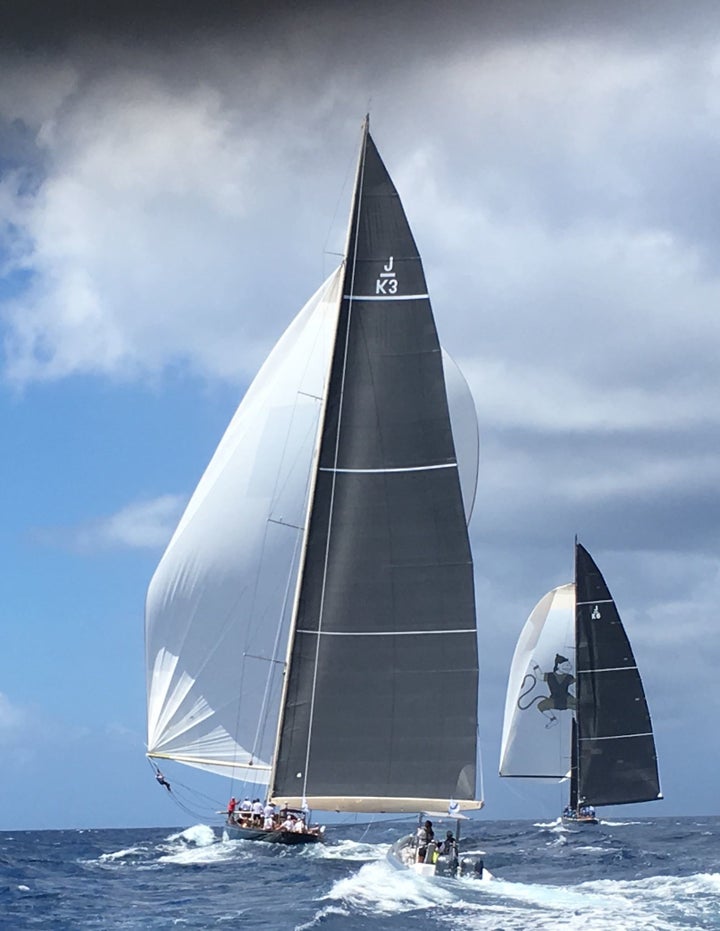
The America’s Cup is the greatest prize in yachting, known the world over as the oldest continual trophy in sport.
But it wasn’t always very sporting. Over its history, huge fortunes have been wagered as billionaires and robber barons squabbled like children in the name of sporting glory. Their enormous yachts were graceful works of art, but the dueling egos of the owners often turned the racing ugly long before the starting gun.
In 1851, the U.S. schooner America stunned fifteen top English yachts when she beat them all in a race around the Isle of Wight. The owners gave the silver trophy over to the care of the New York Yacht Club, along with a document that set out the terms under which future challengers might compete to win it back. This document was known as the Deed of Gift; over the years it has been at the centre of more ungentlemanly behaviour than any contract in the world of sport.
The America’s Cup has seen only brief periods of amicable racing and sportsmanlike conduct. Long forgotten are Lieutenant and Mrs William Henn, who in 1886 challenged for the Cup with their luxury live-aboard Galatea, towing their dinghy behind them. Galatea’s interior boasted a Victorian iron fireplace, mirrors, paintings, potted palms and leopardskin rugs, along with a menagerie of domestic animals that included a cat, a dog, a raccoon, and a monkey named Peggy who helped haul up the sails. Gone too are the days when jovial tea magnate Sir Thomas Lipton endeared himself to the America public as the gracious loser of five consecutive America’s Cup challenges over a period of thirty years.
In the 1890s, yachting began to attract wealthy plutocrats, some with more money than sense. The 4th Earl of Dunraven—a hugely admired Edwardian aristocrat and dandy, fond of big game hunting, and co-author of a book on Spiritualism with homerotic overtones—crossed the Atlantic to pit his skills against those of a NYYC clique that included J.P.Morgan, William K Vanderbilt, August Belmont, and Henry Astor Carey. He challenged twice for the Cup, and twice failed to lift it. By now big boat yacht racing was a huge tourist draw in New York Harbor, and Dunraven felt he was unfairly and deliberately impeded by the large spectator fleet of following steam vessels. His belligerent nature came to a boil when he openly accused the NYYC defender Oliver Iselin of cheating by adding ballast overnight to lengthen the defender’s waterline. Dunraven lost the ensuing inquest, was ejected from the NYYC, ridiculed even in his own country, and disappeared from public view.
Several decades later, evidence came to light that suggests Dunraven may have been on to something after all. The American yacht Defender had a top secret inflatable bladder in its rudder. It was operated by a dedicated crewman Ed Wood who was sworn to secrecy and kept far away from the inquest. ‘Floodable’ ballast later became common on racing yachts, but at the time it was a likely violation of the rules.
Such is the pattern of continual evolution in America’s Cup yachting: technical breakthroughs that bend the rules, and temper tantrums among the sailors.
Given the lopsidedness of the Deed of Gift, it was not surprising that it triggered major meltdowns. Up until 1920, the NYYC was able to field a fleet of yachts to defend the Cup against a single challenger, which then had to sail across the Atlantic ‘on her own bottom’. This meant she would be built more heavily than the local American defenders, who had the further advantage of local knowledge of wind, tides and shoals. The Scottish-built 1887 challenger Thistle’s hull remained wrapped in tarpaulins right up until start of the AC trials in New York harbor. Divers were hired to look for underwater anomalies. With the risk of this kind of secrecy and spying becoming a major factor in boat design, the NYYC changed the Deed of Gift so that any challenger had to declare her specifications a full ten months in advance of the Cup racing.
Protected by fluid rules like these, the Cup remained bolted to a wooden bench in the trophy room of the New York Yacht Club until 1983 when Dennis Connor, a former AC winner as their helmsman, contrived to become the first American to lose the Cup. Giving up a commanding lead in the final race with an inexplicable tactical blunder, the masterful Connor immediately submitted a challenge to win it back—this time on behalf of the San Diego Yacht Club. Big money was at stake as always, but now many more entities were involved, what with corporate sponsorship, TV rights and the lucrative on-shore ‘AC Village’. A period of court battles, ‘keelgate’, and repeated cross-examination of the Deed of Gift ensued, during which time Australia, New Zealand, and even land-locked Switzerland took possession of the Cup, only to see Oracle billionaire Larry Ellison win it back in 2010 for the good ol’ USA.
This May and June, in the deep waters of Bermuda’s Great Sound, five nations will compete for the right to challenge the USA for possession of the ‘Auld Mug’. In recent years, the sport has evolved rapidly into Formula One on water, with all the glory and risk that entails. The teams will be driving modern speed machines that bear little resemblance to the elegant ladies of the past. Able to sail at three times the velocity of the wind with the aid of seven-story high aircraft wings, their modern high tech carbon fiber catamarans will criss-cross the racecourse at speeds in excess of 50mph, the only contact with the water a trio of scythe-like blades. Six-man teams of uber-fit ironmen in helmets and wetsuits skip across the trampoline netting as they jibe and tack, pulling several Gs of force. Long days at the gym pay off as they pump hydraulic winches that trim the massive wing, daggerboards and foresails. Each yacht cost tens of millions to design and build; yet an unexpected gust or squall could snap it a like a twig. The murderous machines have already claimed the life of one unfortunate British sailor, Andrew “Bart” Simpson, trapped under the splintered rigging of Artemis Racing’s trial boat in the San Francisco Bay. America’s Cup racing has become an extreme sport.
Old ghosts return to haunt the reefs of Bermuda
The America’s Cup in 2017 will be arguably a fairer contest than it has ever been. In Bermuda’s relatively neutral waters, an exacting elimination series will determine the fastest challenger nation, and that nation will face the current holder Oracle Team USA in the 1:1 finals. All boats are built within restricted dimensions and tolerances, yet there is plenty of room for individual innovation in below-the-deck systems and electronics. The ultimate winner will be the boat that consistently times its starts right, picks the best wind angles, avoids the lulls, out-manoeuvres its rivals, and manages to ‘fly’ round the course on its hydrofoils without ever dropping down onto its hulls.
In stark contrast to the catamarans, Bermuda will also host in June a regatta for the newly revived J-Class yachts. The Js are massive and elegant ‘gentlemen’s yachts’, designed to compete for the Cup in the 1930s, and felt by many to be the most beautiful sailing craft ever built. They have vast sail areas, gleaming fittings and coachwork, and scimitar-like overhangs, and they bury their rails in the foam as upwards of thirty crew cling to their slippery topsides. Only three originals have survived, but in recent years six more Js have been built in strict compliance with the original 1930s drawings.

Modern classic Hanuman (J-K6) holds off 1930 wooden original Shamrock V (J-K3)
It is March 18th 2017: I find myself in the waters off the Caribbean island of St Barths, bumping around in a high-speed RIB speedboat in the confused chop at the start line of Race 4 of the Bucket Regatta, where for the first time in history, six J-class yachts are racing against each other. This week will serve as the final warm-up before the Bermuda showdown, where two or three more Js will join the fleet. I have temporarily joined the support team for one of the yachts, bringing them alternative sails minutes before the start, and chasing them around the course, looking out for any parts (or crew) that might get lost overboard.
These graceful giant Js seem to have been genetically recreated from their ancestors, and to be close to the start as they circle me and hunt each other down feels as awe-inspiring as a trip to Jurassic Park. They have become the playthings of a new breed of plutocratic yachtsman. Once again, pride and honour are at stake, as friendly competition and sporting glory give way to fierce rivalries and personal feuds.
The new J-class clones feature carbon fiber masts and booms, and modern electronics, yet they carry over some of the handling quirks of their forbears. In the ‘30s, certain hull shape and sail plan combinations seemed to slice better through heavy seas, while others performed well in light winds. It’s not hard to imagine that the new owners, too, might have inherited some of the traits of their yachts’ former proprietors.
Take, for example, the 1937 challenger Endeavour II, sold for scrap before WW2 but brought back to life in 2009 as the 136ft Hanuman (J-K6). She was originally built for Sir ‘Tommy’ Sopwith, the British aeronautical designer, who brought with him a host of technological innovations such as sophisticated wind gauges and the quadrilateral ‘Greta Garbo’ jib. When Sopwith first arrived in the US it was apparent to all that he had a faster boat than that of the US defender Harold ‘Mike’ Vanderbilt. But Sopwith ran into an eleventh hour pay dispute with his professional crew, and had to quickly round up enthusiastic amateurs to race his boat. Their hands bled from the rope handling, and Sopwith lost a protest hearing that, of course, was overseen by the NYYC race committee. With his crew tiring and his afterguard demoralised, Sopwith’s campaign came to a sad end when Vanderbilt out-psyched him and won the series 4-2.
Dr. Jim Clark, legendary Silicon Valley technologist and entrepreneur, founder of Silicon Graphics Inc and Netscape, is now the owner of the beautiful Hanuman J-K6, which is based on Sopwith’s 1937 Endeavour II. Like Sopwith, Clark came to sailing relatively late in life. He fell in love with the J class when he chartered Endeavour I, a 1934 original that is still sailing today. He had his own J built, by Royal Huisman of Holland, making sure that she had the most state-of-the-art electronic systems in the current fleet. He initially helmed her himself aided by a largely amateur crew, and began to race against the likes of Velsheda (J7) and Ranger (J5), despite the fact that those two Js had an ongoing feud, having twice collided on the racecourse and caused damage in the tens of thousands. But Clark got into a dispute with the J-Class Association over his suggestions of ways to limit the expense of running J-class yachts on the annual Caribbean/Mediterranean regatta circuit. He proposed, quite reasonably, that the number of professionals in the crews should be balanced with a quotient of amateurs. He also volunteered to start a joint charity fund to help protect the world’s oceans. When the other owners derided these suggestions, he realised that any notions of ‘Corinthian’ yachting were out the window. These days Hanuman is raced by the all-professional crew from his record-breaking carbon fiber speedster megayacht Comanche, and it costs him tens of thousands of dollars every time Hanuman heads out to the start line.
But Jim Clark must be a happy man at the end of the St Barts Bucket Regatta. On the final day of the five-race series, I skirt a fence and clamber to the top of a rocky headland high above the north east corner of the island, with a 15-knot Atlantic breeze strong in my face. Far below me I watch six magnificent J-class beauties round the point, almost neck-and-neck after an hour and a half of racing, their black sails gleaming in the sun, long bows slicing through the rollers. As they skirt the reefs, Hanuman takes over the lead from Ranger, with its owner the Georgian real estate magnate John Williams watching from the cockpit. To win the series, Hanuman needs to distance herself from Velsheda, the 1933 classic owned and helmed by Dutch fashion empire tycoon Roland de Waal, who has led the series all week and seems assured of overall victory. For a moment Hanuman appears boxed in; but like a thoroughbred race horse she pulls away, giving her rivals dirty air, leaving the fleet in her wake. She rounds the final mark, hoists a massive black spinnaker emblazoned with the Indonesian wind-god who named her, and powers across the finish line in first place, to win the overall Regatta.
